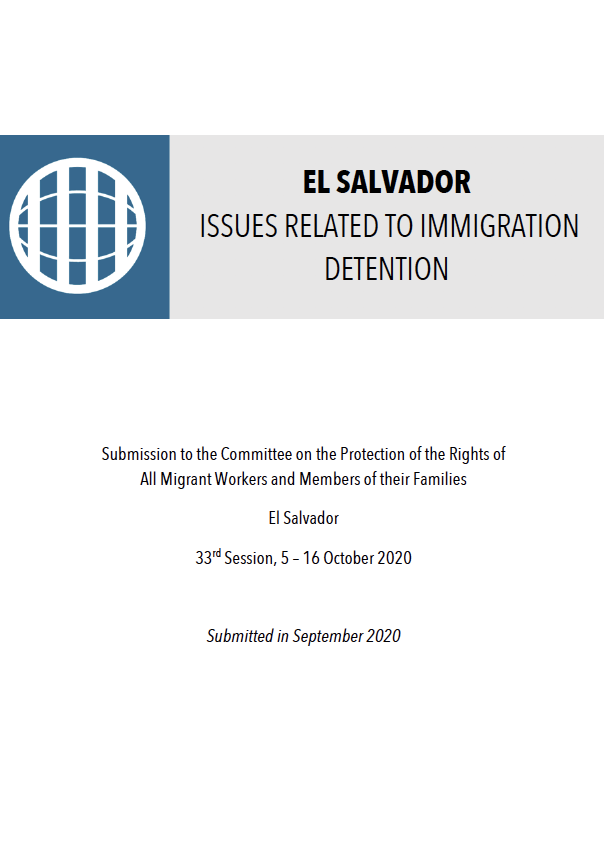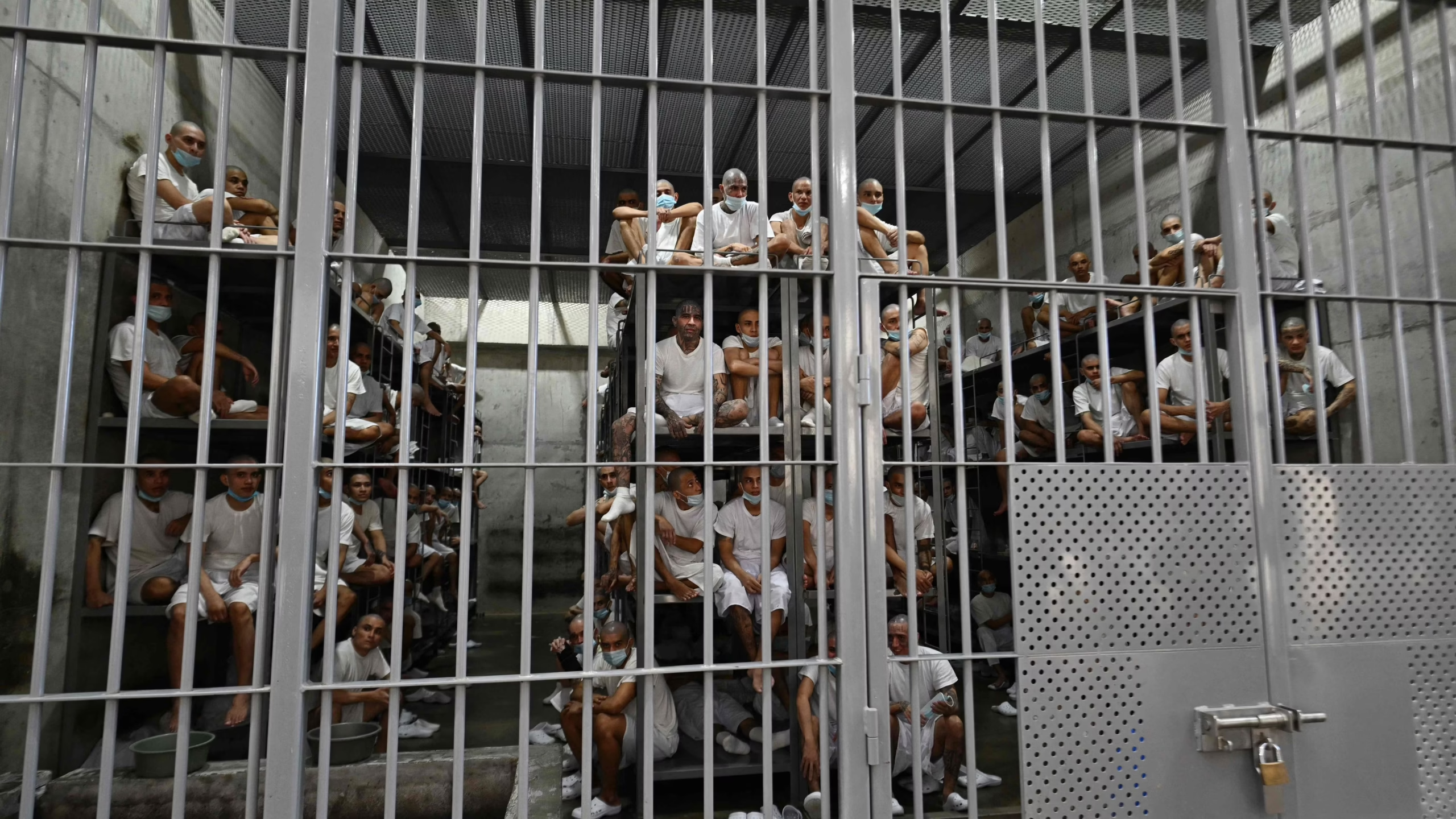On 7 April, the US Supreme Court ruled that the Trump administration could continue deporting alleged Venezuelan gang members to El Salvador’s “supermax” CECOT prison, referred to by observers as a “human rights black hole.” In March, more than 260 people were deported and placed in the facility under the US’s controversial agreement with El […]
El Salvador: Covid-19 and Detention
Responding to the Global Detention Project’s Covid-19 Survey, the UN Human Rights regional office in Panama (ROCA) reported that El Salvador has not established a moratorium on new immigration detention orders and that the country is not contemplating the measure. ROCA also explained that no immigration detainees have been released and that there are no […]

El Salvador: Covid-19 and Detention
In early March, El Salvador introduced a strict quarantine lock-down, despite authorities announcing that there were no confirmed cases of Covid-19. The country’s measures—which have included the use of the armed forces and national police to enforce quarantine, and the detention of people in forced confinement for breaching the lock-down—have prompted concerns that President Bukele […]

Last updated: September 2015
El Salvador Immigration Detention Profile
While almost 40 percent of El Salvador’s population lives abroad, it is also a transit and destination country. Migrants apprehended without proper documents are detained as they await deportation. Although immigration detention is not properly regulated in law, in practice El Salvador tends to confine more than 1,000 migrants per year (1,200 in 2009) and operates a dedicated immigration detention centre called the Centro de Atención Integral para el Migrante (CAMI).
A small and densely populated country, El Salvador has long been a country of emigration. However, mass emigration from the country has attracted people from nearby countries in search of jobs, particularly in the agriculture and construction sectors. El Salvador also serves as an important transit state for people migrating north. In 2004 border guards apprehended 2,332 persons without documents, and 2,255 in 2005.[1]
El Salvador’s immigration regime is established in a series of long-standing pieces of legislation: the 1958 Migration Law (Ley de Migración), and its accompanying 1959 Regulation of the Migration Law, as well as the 1986 Foreigners’ Law (Ley de Extranjería). A draft of a new migration and foreigners’ law, intended to consolidate and replace the existing legislation, has been in negotiations for several years. The 2002 Refugees Law (Ley para la Determinación de la Condición de Personas Refugiadas) and the 2005 Regulation of the Refugees Law provide the legal framework for the country’s asylum and refugee regime.[2]
The Refugee Law provides for the detention of persons seeking asylum for a maximum of three days during the initial screening procedures (articles 15-16). However, the Migration Law and the Foreigners’ Law do not provide for administrative detention. The only provision mentioning detention is article 60 of the Migration Law, in the section titled “Sanctions.” Accordingly, a foreigner who enters El Salvador in an undocumented manner can be punished with a fine, which can be replaced by a detention (arresto) of up to 30 days. In 2003, the Supreme Court of El Salvador declared such deprivation of liberty as unconstitutional because under article 14 of the country’s constitution deprivation of liberty ordered by administrative organ can last only up to five days. In 2011 the Supreme Court found that Salvadorian legislation does not provide for detention as part of expulsion procedures.[3]
Despites this legal vacuum, in practice migrants who are apprehended without papers are detained to prepare their deportation.[4] As observed by civil society organisations, like Nicaragua, Honduras, and Guatemala, in El Salvador authorities systematically apply immigration detention and there are no alternatives to detention. The majority of detainees are not from Central America.[5]
According to statistics from the Migration Directorate, 372 persons were detained in 2006, 1,645 in 2007, 1,527 in 2008, and 1,229 in 2009.[6] As of 23 October 2008, there were five people in detention.[7]
A handbook produced by the Salvadoran border guards division of the Migration Directorate states that the maximum time migrants can be held in a detention centre is five days. Governmental sources reported in 2008 that the average time period people spend in immigration detention was roughly five days.[8] However, in 2007 non-governmental organizations observed that detention typically lasted between 45 days and 3 months.[9] According to information provided by advocacy organisation, in 2014 the average length of detention was 30 days though some cases reportedly lasted considerably longer.[10]
There is no automatic review of detention. Civil society organisations, such as Programa de Atención a Personas Refugiadas en El Salvador (IAES PARES), offer legal assistance to detainees.[11]
In July 2008 the country opened a dedicated immigration detention facility, called the Centro de Atención Integral para el Migrante (CAIM). It appears to be the only long-term immigration facility used in El Salvador. The centre is managed by the Migration Directorate (Dirección General de Migración y Extranjería) and is located at the premises of the Ministry of Justice and Public Security in San Salvador. Before opening the centre, migrants were generally detained in police facilities, particularly those located in border areas (División de Fronteras de la Policía Nacional Civil).[12]
According to a 2008 report from the Salvadoran government, the CAIM facility has a maximum capacity of 80. The building has three floors and a basement. There is a kitchen and an eating room, alongside a visiting, entertainment, and recreation room. The centre is divided in four sections for men, women, families, and vulnerable persons, each equipped with a bathroom. The government reportedly spent almost 190,000 USD for the renovation and reconstruction of the building to set up the centre.[13] According to the government, detainees receive adequate food and medical, psychological, and social assistance. The National Civil Police and the Ministry of Health and Social Assistance signed an agreement under which the latter is to ensure prompt medical assistance for detainees.[14]
Unaccompanied minors are taken into charge by the Salvadoran Institute for the Integral Development of Children and Adolescents (Instituto Salvadoreño para el Desarrollo Integral de la Niñez y la Adolescencia).[15] However, children who migrate with their parents or guardians are have been with their families at the CAIM facility.[16]
[1] Government of El Salvador. CONSIDERATION OF REPORTS SUBMITTED BY STATES PARTIES UNDER ARTICLE 73 OF THE CONVENTION: Initial reports of States parties due in 2004: EL SALVADOR. OHCHR. 20 August 2007. http://daccess-dds-ny.un.org/doc/UNDOC/GEN/G07/436/47/PDF/G0743647.pdf?OpenElement, p. 11-20.
[2] Government of El Salvador. CONSIDERATION OF REPORTS SUBMITTED BY STATES PARTIES UNDER ARTICLE 73 OF THE CONVENTION: Initial reports of States parties due in 2004: EL SALVADOR. OHCHR. 20 August 2007. http://daccess-dds-ny.un.org/doc/UNDOC/GEN/G07/436/47/PDF/G0743647.pdf?OpenElement, p. 8.
[3] International Detention Coalition (IDC). INFORME REGIONAL DETENCIÓN MIGRATORIA Y ALTERNATIVAS A LA DETENCIÓN EN LAS AMÉRICAS. October 2014, p. 21 and 35. Norma Verónica Ardón. “Estudio Migratorio de el Salvador”. In Instituto Centroamericano de Estudios Sociales y Desarrollo (INCEDES) and Sin Fronteras (Eds.). Estudio comparativo de la legislación y políticas migratorias en Centroamérica, México y República, November 2011. Dominicana. http://www.sinfronteras.org.mx/index.php/es/publicaciones/de-sin-fronteras/informes-anuales-2/380-estudio-comparativo-de-la-legislacion-y-politicas-migratorias-en-centroamerica-mexico-y-republica-dominicana. P. 195.
[4] Norma Verónica Ardón. “Estudio Migratorio de el Salvador”. In Instituto Centroamericano de Estudios Sociales y Desarrollo (INCEDES) and Sin Fronteras (Eds.). Estudio comparativo de la legislación y políticas migratorias en Centroamérica, México y República, November 2011. Dominicana. http://www.sinfronteras.org.mx/index.php/es/publicaciones/de-sin-fronteras/informes-anuales-2/380-estudio-comparativo-de-la-legislacion-y-politicas-migratorias-en-centroamerica-mexico-y-republica-dominicana. P. 197.
[5] International Detention Coalition (IDC). INFORME REGIONAL DETENCIÓN MIGRATORIA Y ALTERNATIVAS A LA DETENCIÓN EN LAS AMÉRICAS. October 2014, p. 5. Undisclosed source. Interview with Izabella Majcher (Global Detention Project). September 2013.
[6] Norma Verónica Ardón. “Estudio Migratorio de el Salvador”. In Instituto Centroamericano de Estudios Sociales y Desarrollo (INCEDES) and Sin Fronteras (Eds.). Estudio comparativo de la legislación y políticas migratorias en Centroamérica, México y República, November 2011. Dominicana. http://www.sinfronteras.org.mx/index.php/es/publicaciones/de-sin-fronteras/informes-anuales-2/380-estudio-comparativo-de-la-legislacion-y-politicas-migratorias-en-centroamerica-mexico-y-republica-dominicana. P. 200
[7] Government of El Salvador. 2008. RESPUESTAS ESCRITAS DEL GOBIERNO DE LA REPÚBLICA DE EL SALVADOR EN RELACIÓN CON LA LISTA DE CUESTIONES (CMW/C/SLV/Q/1) RECIBIDAS POR EL COMITÉ PARA LA PROTECCIÓN DE LOS DERECHOS DE TODOS LOS TRABAJADORES MIGRATORIOS Y DE SUS FAMILIARES EN RELACIÓN CON EL EXAMEN DEL INFORME INICIAL DE LA REPÚBLICA DE EL SALVADOR (CMW/C/SLV/1). CMW/C/SLV/Q/1/Add.1. 24 October 2008. OHCHR. www2.ohchr.org/english/bodies/cmw/docs/CMW-C-SLV-Q1-Add1_sp.doc, p. 11.
[8] Government of El Salvador. 2008. RESPUESTAS ESCRITAS DEL GOBIERNO DE LA REPÚBLICA DE EL SALVADOR EN RELACIÓN CON LA LISTA DE CUESTIONES (CMW/C/SLV/Q/1) RECIBIDAS POR EL COMITÉ PARA LA PROTECCIÓN DE LOS DERECHOS DE TODOS LOS TRABAJADORES MIGRATORIOS Y DE SUS FAMILIARES EN RELACIÓN CON EL EXAMEN DEL INFORME INICIAL DE LA REPÚBLICA DE EL SALVADOR (CMW/C/SLV/1). CMW/C/SLV/Q/1/Add.1. 24 October 2008. OHCHR. www2.ohchr.org/english/bodies/cmw/docs/CMW-C-SLV-Q1-Add1_sp.doc, p. 11.
[9] Instituto de Estudios Políticos para América Latina y África and Médicos Sin Fronteras. Informacion comparada sobre detencion de solicitantes de asilo en Centroamerica y Caribe. 2007. http://www.gloobal.net/iepala/gloobal/fichas/ficha.php?entidad=Textos&id=4303&opcion=documento#ficha_gloobal.
[10] International Detention Coalition (IDC). INFORME REGIONAL DETENCIÓN MIGRATORIA Y ALTERNATIVAS A LA DETENCIÓN EN LAS AMÉRICAS. October 2014, p. 23.
[11] International Detention Coalition (IDC). INFORME REGIONAL DETENCIÓN MIGRATORIA Y ALTERNATIVAS A LA DETENCIÓN EN LAS AMÉRICAS. October 2014, p. 33 and 69.
[12] Norma Verónica Ardón. “Estudio Migratorio de el Salvador”. In Instituto Centroamericano de Estudios Sociales y Desarrollo (INCEDES) and Sin Fronteras (Eds.). Estudio comparativo de la legislación y políticas migratorias en Centroamérica, México y República, November 2011. Dominicana. http://www.sinfronteras.org.mx/index.php/es/publicaciones/de-sin-fronteras/informes-anuales-2/380-estudio-comparativo-de-la-legislacion-y-politicas-migratorias-en-centroamerica-mexico-y-republica-dominicana. P. 199. See also: Michael Flynn. 2002. “Donde Esta la Frontera?” Bulletin of the Atomic Scientists. July/August 2012. .
[13] Government of El Salvador. 2008. RESPUESTAS ESCRITAS DEL GOBIERNO DE LA REPÚBLICA DE EL SALVADOR EN RELACIÓN CON LA LISTA DE CUESTIONES (CMW/C/SLV/Q/1) RECIBIDAS POR EL COMITÉ PARA LA PROTECCIÓN DE LOS DERECHOS DE TODOS LOS TRABAJADORES MIGRATORIOS Y DE SUS FAMILIARES EN RELACIÓN CON EL EXAMEN DEL INFORME INICIAL DE LA REPÚBLICA DE EL SALVADOR (CMW/C/SLV/1). CMW/C/SLV/Q/1/Add.1. 24 October 2008. OHCHR. www2.ohchr.org/english/bodies/cmw/docs/CMW-C-SLV-Q1-Add1_sp.doc, p. 9-10.
[14] Government of El Salvador. 2008. RESPUESTAS ESCRITAS DEL GOBIERNO DE LA REPÚBLICA DE EL SALVADOR EN RELACIÓN CON LA LISTA DE CUESTIONES (CMW/C/SLV/Q/1) RECIBIDAS POR EL COMITÉ PARA LA PROTECCIÓN DE LOS DERECHOS DE TODOS LOS TRABAJADORES MIGRATORIOS Y DE SUS FAMILIARES EN RELACIÓN CON EL EXAMEN DEL INFORME INICIAL DE LA REPÚBLICA DE EL SALVADOR (CMW/C/SLV/1). CMW/C/SLV/Q/1/Add.1. 24 October 2008. OHCHR. www2.ohchr.org/english/bodies/cmw/docs/CMW-C-SLV-Q1-Add1_sp.doc, p. 9-10.
[15] Norma Verónica Ardón. “Estudio Migratorio de el Salvador”. In Instituto Centroamericano de Estudios Sociales y Desarrollo (INCEDES) and Sin Fronteras (Eds.). Estudio comparativo de la legislación y políticas migratorias en Centroamérica, México y República, November 2011. Dominicana. http://www.sinfronteras.org.mx/index.php/es/publicaciones/de-sin-fronteras/informes-anuales-2/380-estudio-comparativo-de-la-legislacion-y-politicas-migratorias-en-centroamerica-mexico-y-republica-dominicana. P. 199.
[16] FESPAD. 2º Examen Periódico Universal de El Salvador: informes official y alternativos. December 2014. http://www.lwfcamerica.org/uploaded/content/article/1828638740.pdf, p. 20.
DETENTION STATISTICS
DETENTION CAPACITY
ALTERNATIVES TO DETENTION
ADDITIONAL ENFORCEMENT DATA
PRISON DATA
POPULATION DATA
SOCIO-ECONOMIC DATA & POLLS
LEGAL & REGULATORY FRAMEWORK
Does the Country Have Specific Laws that Provide for Migration-Related Detention?
Detention-Related Legislation
GROUNDS FOR DETENTION
Criminal Penalties for Immigration-Related Violations
LENGTH OF DETENTION
DETENTION INSTITUTIONS
Custodial Authorities
PROCEDURAL STANDARDS & SAFEGUARDS
COSTS & OUTSOURCING
COVID-19 DATA
TRANSPARENCY
MONITORING
NATIONAL HUMAN RIGHTS MONITORING BODIES
NATIONAL PREVENTIVE MECHANISMS (OPTIONAL PROTOCOL TO UN CONVENTION AGAINST TORTURE)
NON-GOVERNMENTAL ORGANISATIONS (NGOS)
GOVERNMENTAL MONITORING BODIES
INTERNATIONAL DETENTION MONITORING
INTERNATIONAL TREATIES & TREATY BODIES
International Treaties Ratified
Ratio of relevant international treaties ratified
Individual Complaints Procedures
Relevant Recommendations or Observations Issued by Treaty Bodies
Global Detention Project and Partner Submissions to Treaty Bodies
> UN Special Procedures
Visits by Special Procedures of the UN Human Rights Council
> UN Universal Periodic Review
REGIONAL HUMAN RIGHTS MECHANISMS
Regional Legal Instruments
HEALTH CARE PROVISION
HEALTH IMPACTS
COVID-19
Country Updates
Government Agencies
Directorate General of Migration and Foreigners: http://www.migracion.gob.sv/
Ministry of Foreign Affairs - https://rree.gob.sv/
International Organisations
UNHCR El Salvador: http://www.unhcr.org/el-salvador.html
IOM El Salvador: https://www.iom.int/countries/el-salvador
NGO & Research Institutions




